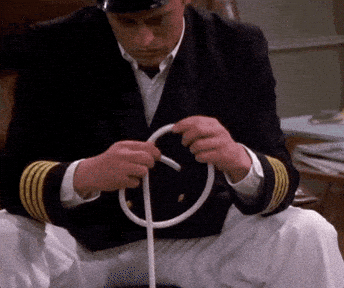- Skills School Forgot
- Posts
- Outdoors Skills Sunday | 5 Essential Knots Everyone Should Know
Outdoors Skills Sunday | 5 Essential Knots Everyone Should Know
Today we're going to cover the 5 most essential knots everyone should know to tie. Knot tying is one of the most useful skills to know when in a bind (pun intended)

Gif by friends on Giphy
Why is Knot Tying Important?
Knot tying isn’t just for sailors and extreme mountain climbers. A simple knot can make DIY home projects move twice as fast while staying twice as secure. Just because duct tape can fix anything doesn’t mean it’s always the best tool for the job. Let’s dive in to 5 important knots and their real-life applications.
The 5 Most Essential Knots You Should Know
Square Knot (Reef Knot)
The Square knot is a great example of a binding knot. It is best used when you have two ropes the same diameter. It’s simple, reliable, and perfect for beginners. This knot is great for securing a bundle of items since it won’t slip. The square knot is commonly used when:
Tying your shoes
Securing a light bundle of wood
Securing a bundle of rods, ores, or stick-like sports equipment
Wrapping a gift
How to Tie a Square Knot:
Bowline Knot
This knot creates a fixed loop at the end of a piece of rope. You can use this knot anytime you need to create an anchor point out of thin air. It’s sometimes referred to as “the king of knots” since it is easy to tie and untie while being a great choice for securing heavy weights. It’s commonly used in boating but can also be used in these more practical situations:
Hanging a hammock/anchor around a tree
Attaching two pieces of rope together
Securing a cooler top down
As a Safety ring to throw to someone in need
How to Tie a Bowline Knot
Clove Hitch
This useful knot is similar to the bowline knot but instead of creating an anchor point, the clove hitch ties to an anchor point. The clove hitch can slip so don’t trust it with your life, but definitely trust it to keep items in place during a windstorm. It’s an easy and quick knot to tie so you can use it to secure objects to a pole or other fixed anchor point. Practical uses:
Tying down a tarp
Tying patio furniture during a storm
Securing cargo to a car or in a truck bed
Hanging decorations
How to Tie a Clove Hitch
Sheet Bend (Weaver’s Knot)
This knot is useful when joining together two different ropes of different sizes. It will work just as well if the ropes are the same size. When you’re stuck with two short ropes, use this knot to create a single reliable line. Here are some other uses:
Pulling cable through a wall
Rope rescue line
Joining two lines of different diameter
Extra-long jump rope for Double Dutch (kidding)
How to Tie a Sheet Bend Knot
Cow Hitch
This is another hitch knot that is extremely simple, effective, and easily used in life. This knot allows a rope to anchor to any object its able to wrap around. This knot shouldn’t be used as a long-term solution or in life saving applications. If you need to anchor off to a pole, tree, ring, branches, or other cylindrical object, use this knot. Some examples:
Hanging items to a hook
Tying a rope/string to a lanyard
Attaching a ring to a rope to play ring toss at a bar
Attaching tags to luggage
How to Tie a Cow Hitch
Know Someone Who Would Love This?
The link below will take you to the magical land of learning also known as the landing page. If you were forwarded this email, you can receive this daily newsletter tomorrow by clicking that blue button below and sharing your email address.